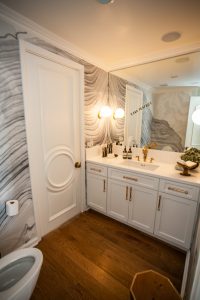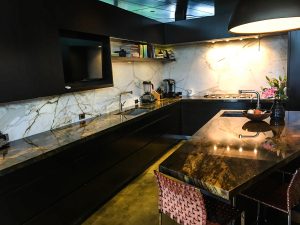Zooming through the world of interior luxury and tech in L.A. By Elle H-Millard, CKD
Vroom! Vroom!
That’s how the Dwell on Design trade show and tour revved up in Los Angeles, as pros from all over the design sphere kicked off the event with a test drive in a 403-horsepower Karma Revero. This ultra-luxury hybrid sports car has an incredibly silent start with enough power to go from 0 to 60 in under 6 seconds. But that’s too fast to bask in the wows and stares while navigating the streets of L.A. in such an exquisite vehicle. With a solar roof that charges the batteries, it’s perfect for soaking up the sunshine in Southern California — where it’s built. Starting at $130,000, it’s certainly not for average commuter, but it is for the driver who embraces the full luxury experience — and this was just the start to a lavish and extraordinary week focused on ultimate design.
The trade show, held at the Los Angeles Convention Center, was the hub for the week, but the whole experience included the L.A. Design Trail, a mix of showrooms and artisans’ studios, and the Dwell Homes Tour. Among the highlights:
- Showtime
This intimate show was easy to navigate and experience each of the exhibitors’ booths. A few of those showing caught designers’ attention, including Method Home and Swing Tables, which produces luxury prefabricated dwellings.
Among the speakers at Showtime, industrial designer Karim Rashid emphasized the importance of breaking down barriers to “live in the future, to fully embody the human experience” as it relates to design, while Jonathan Adler, a designer and potter, discussed the ironies of the luxury market, noting you can make the highest-end product from the most basic elements of the earth: water and dirt. He then cracked up the crowd with his observation, “I learned early on that the wife is always right, unless the husband is gay.”
- Casa Perfect
It was a delightful surprise to have a private VIP-only lunch in Elvis Presley’s former residence nestled in the high ground of Beverly Hills. (And no, it wasn’t peanut butter-and-banana sandwiches!) The couple leasing the home has turned it into a showroom for the trade to enjoy the environment, relax for lunch and shop for design elements and decor. Most everything in the home is for sale — even built-in furniture pieces and fixed objects. Much of the home’s structure remains intact from when The King lived there, however there are some features that have been restored or replaced due to wear. All pieces for sale, however, are contemporary items, and not vintage goods or antiques. This museum-like home takes the showroom concept to an entirely different level, where the focus is on the overall experience. But you can’t just stroll in wearing your blue suede shoes — visitors must make an appointment (group or individual) to tour the space.
- Barrington House
It’s not often that one enters a home from the rooftop, layered and built into the land, giving a large home a subtle yet impressive landscape view. But that was the case at Barrington House, where influencers, media and
architects were invited for a private dinner as part of the Dwell on Design Home Tours. And as if there weren’t enough pampering, this experience was breathtaking for a visually inspired crew. The home was layered into the sloping terrain with sprawling basketball and tennis courts to anchor the property.
Although stunning, the property was built with sustainability in mind. Lucky for me, I sat with the homeowners and architect during dinner, and asked lots of questions about the home’s technology and sustainability. When asked about technology in the home, the initial response was that it was, of course, fitted with the most current technology. But digging a little deeper, I learned specifically what technology was implemented in the kitchen and baths — and that was quite surprising. The architect and homeowners agreed that since tech is changing so quickly, they didn’t want to date the home by implementing gadgets merely for the sake of having them. They were proud to have app-controlled thermostats, music systems, shades and lighting. However, they did not include smart technology and connectivity in either the kitchen or bath spaces.
The conversation then turned to the roof, where solar panels power not only the home, but also both homeowners’ all-electric Teslas. The panels create enough energy to power their home and vehicles and “give back to the grid” — so the electric company owes them money.
The homeowners said the most expensive part of living in the home is the water bill, even though a majority of the land is covered with artificial turf.
An interesting point bubbled to the surface. The homeowners want to drive a new car every two years, so they replace their Teslas (or whatever vehicle they happen to be driving at the time) with that frequency.
So, let’s think about this: they wanted technology in the kitchen and bath to last a long time, and not become obsolete quickly or disrupt the home frequently with renovations. However, despite the high level of technology in the Teslas, it’s acceptable to swap cars every two years. The cars, which start at around $80,000 to buy, are on a leasing program, yet a luxury refrigerator (about $8,000) is not.
The concept is fascinating as we think about the perception and value placed on kitchen and bath design today.
For an overview of the Dwell on Design show, click here: https://youtu.be/JJAMJM6XZ8E










